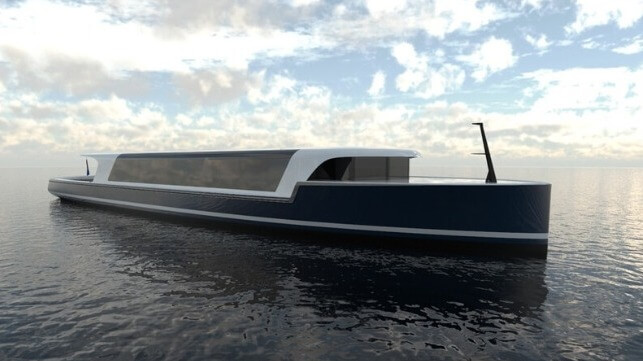First Solid Form Hydrogen Propulsion Vessel Ordered for Amsterdam

The construction contract has been awarded for a hydrogen demonstration vessel that will use a new solid form hydrogen for propulsion that researchers believe will pave the way for a safer and broader application of hydrogen to fuel vessels. Known as Neo Orbis, the demonstration vessel is expected to start trials in June 2023 as the next phase in the multi-year European H2Ships program.
The construction contract for the Neo Orbis was awarded to Next Generation Shipyards in the Netherlands. The tender process for the vessel’s construction began in March 2022. The vessel will be approximately 65 feet long similar to the tour boats that have operated in Amsterdam for years transporting passengers and offering sightseeing excursions. It is designed to operate both in Amsterdam’s canals as well as the seaport area between Amsterdam and Ijmuiden.
According to the project organizers, it will become the first ship in the world sailing on electricity, propelled with hydrogen in a solid form as the energy carrier. The fuel is made by mixing sodium borohydride powder with a stabilizer and ultrapure water into an aqueous non-combustible liquid fuel. The dissolved sodium borohydride reacts with a catalyst, producing hydrogen while the spent fuel is converted back to sodium borohydride. In the long term, the project envisions creating a closed system, by turning the residual materials into new sodium borohydride fuel.
The heat extracted in the process is also applied to warm the interior of the vessel while the water is recycled. Two batteries, 25 KWh each, will provide backup energy while a safety system monitors the concentration of hydrogen and automatically suspends the process well before a dangerous concentration level is reached.
In addition to being a high energy density fuel source, they highlight that it is an innately safer form of energy. Most of the energy is stored on board as sodium borohydride, which is much more stable. It also has a much higher ignition point versus hydrogen gas, which can ignite at room temperature if there is a spark, and even higher than diesel. Another major advantage of this hydrogen carrier is that it can be bunkered safely in many places.
The vessel is seen as an important step in the efforts toward emission-free shipping in the port of Amsterdam by 2050. In addition to serving as the port’s flagship, the project believes it will serve as a model to support the adoption of hydrogen power for inland shipping, short sea, dredging, offshore, and possibly patrol vessels and naval vessels.
The H2Ships project was launched in 2019 to demonstrate the technical and economic feasibility of hydrogen bunkering and propulsion for shipping. Two pilot projects identified in the scope of work were the Neo Orbis vessel and a second pilot for the safe and efficient operation of a newly built hydrogen refueling station to be located in Belgium. H2Ships plans to demonstrate the fueling station with a vessel used for the maintenance of offshore wind farms. The project also called for developing an action plan for the implementation of an H2SHIPS pilot on the river Seine in Paris after the end of the project. H2SHIPS will demonstrate the added value of H2 for water transport and develop a blueprint for its adoption across North-West Europe.
